| THIS WEEK'S ARTICLES |
| The Market Message |
| Why the Dollar Could Weaken in 2020 |
| by John Murphy |
Yesterday's message suggested that commodity prices may be bottoming; which could lead to a better 2020 for the first time in years. Part of that analysis, however, was based on expectations for a lower dollar. That's because a falling dollar is usually necessary for commodity markets to move higher. The last paragraph in yesterday's message explained some reasons why the next year could see a weaker U.S currency. Today's message will elaborate on some of them. The first has to do with the narrowing spread between Treasuries and foreign bond yields. Over the last several years, the spread between higher-yielding Treasury bonds and lower foreign bond yields supported a higher dollar. That spread was caused mainly by a more hawkish Fed which raised interest rates while the rest of the world kept negative bond yields. Over the last year, however, the Fed lowered rates three times and assumed a more dovish stance. That narrowed the spread between U.S. and foreign yields. That's normally negative for the dollar.
Chart 1 plots the spread between the 10-Year Treasury yield and similar maturities for German bunds (blue line) and British gilts (red line). Both lines peaked at the end of 2018, and have fallen throughout 2019. That's the biggest drop in years. The reason for the drop is the steeper decline in Treasury yields over the past year. According to Bloomberg, the 10-Year Treasury yield has dropped 89 basis points over the last year. By comparison, British and German bond yields have fallen 55 and 47 bps respectively. Over that same time span, 10-year Canadian yields (not shown here) fell only 40 bps while Japanese yields were unchanged. The fact that foreign yields fell less than the US is normally supportive to their local currencies.
Four of the six foreign currencies in the USD gained ground against the dollar over the last year -- the Canadian Dollar (more on that shortly), the British pound, the Japanese yen, and the Swiss franc. Over the last three months, five have risen against the dollar -- the pound, the Swedish krona (more on that shortly), the euro, the Swiss franc, and Canadian dollar. Only the more defensive yen lost ground. The krona's recent gain was the result of the Swedish central bank raising its short-term rate out of negative territory for the first time in years. And may have signaled that other foreign central bankers may start doing the same. That would be further supportive of their local currencies. And bad for the dollar. Foreign currencies of countries that export commodities have also had a strong year. That includes the Canadian Dollar.
Chart 1
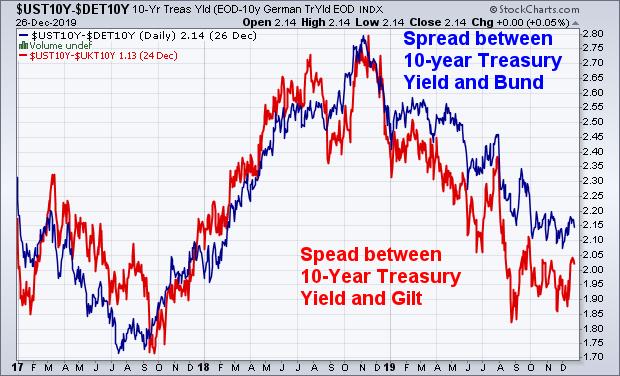
Editor's Note: This is an excerpt of an article that was originally published in John Murphy's Market Message on Friday, December 27th at 1:22pm ET. Click here to read the full article, which includes Charts 2-5.
|
| READ ONLINE → |
|
|
|
| Art's Charts |
| 2019: A Year Filled with Distractions |
| by Arthur Hill |
 2019 was a year with lots of distractions, and yet the S&P 500 recorded 52-week highs in six of the last nine months. The index surged 17.7% the first four months and recorded its first 52-week high in late April. It then finished strong with a new high in late December and is currently around 10% above its April high. Distractions were prevalent throughout these new highs as we heard about the tariff battle, the inverted yield curve and relative weakness in small-caps, among other things. 2019 was a year with lots of distractions, and yet the S&P 500 recorded 52-week highs in six of the last nine months. The index surged 17.7% the first four months and recorded its first 52-week high in late April. It then finished strong with a new high in late December and is currently around 10% above its April high. Distractions were prevalent throughout these new highs as we heard about the tariff battle, the inverted yield curve and relative weakness in small-caps, among other things.
These distractions did not derail the bull market and there were plenty of names that moved higher from May to December. In fact, 93 stocks in the S&P 500 are up more than 20 percent since May, while another 144 are up between 10 and 20 percent (sans dividends). This means around half the components in the S&P 500 are up 10% or more from May to December. Obviously, the year-to-date numbers would include the January to April surge and look even better.
The chart below shows three examples with these distractions, which are nothing more than bear bait. The US-China tariff thing has been on and off all year, but interest in the search term "tariff" peaked in May (source: Google Trends). The S&P 500 was already up 17.7% at the end of April and declined as the tariff battle heated up. A chartist focused solely on price and unaware of the distractions would likely see a normal pullback after a 17.7% surge. In fact, a picture-perfect falling flag formed and the index broke out in early June.
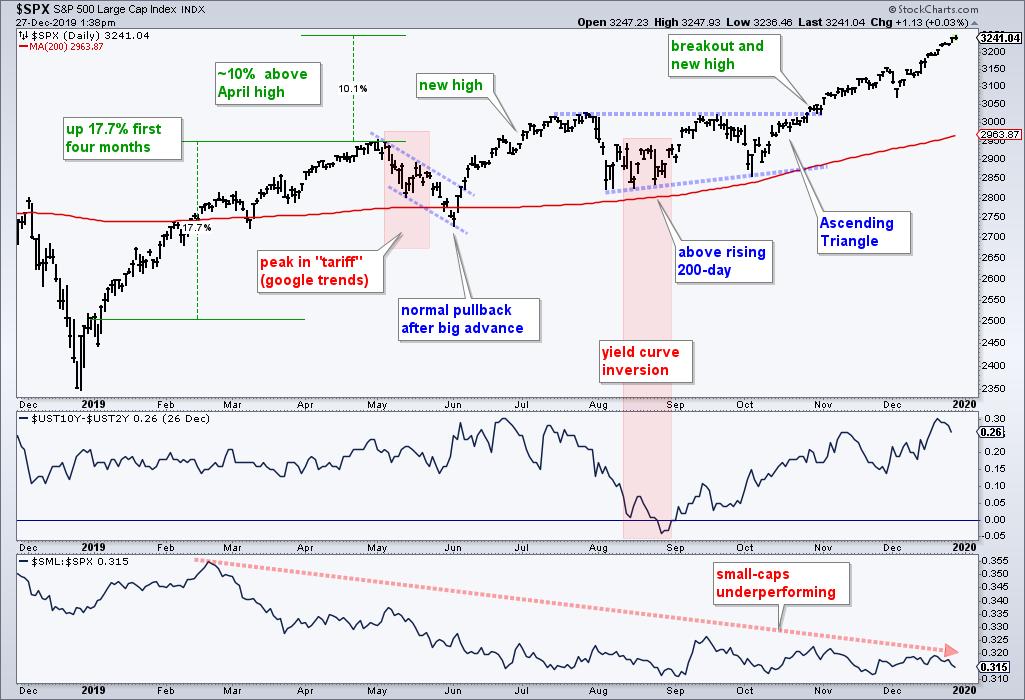
The yield curve distraction surfaced in August as the 10-year Treasury yield moved below the 3-Month Treasury Yield in early August and below the 2-year Treasury yield in late August. This might be important if you are trading bonds, but it was just a distraction for the stock market. The S&P 500 fell sharply for a few days in early August, but then firmed above its early June low and above its rising 200-day SMA. The uptrend was never in jeopardy because there was a higher high in July and a higher low in August. The S&P 500 then went on to new highs as the Finance SPDR (XLF) caught fire and also moved to new highs.
And last, but not least, small-caps have pretty much underperformed all year long. The price relative ($SML:$SPX) hit a new low in early September and bounced around this low in October, November and December. Guess what? Relative weakness in small-caps did not derail the S&P 500. Even at its lowest point (May 31st), the S&P SmallCap 600 was still up around 5% year-to-date. Moreover, $SML is up over 20% year-to-date, which is not exactly weak. Small-caps are underperforming and the price relative is moving lower because $SPX is up over 30% year-to-date. Perhaps relative weakness in small-caps have more to do with relative strength in large-caps.
So what's the moral of the story here? Forget the wall of worry in 2020 and focus on what really matters: price action. The S&P 500 was strong throughout 2019 and the cup was half full pretty much all year. This meant there were plenty of bullish setups to be had and we needed a bullish mindset to take advantage. If small-caps are lagging, then avoid small-caps. But don't throw out the baby with the bath water. If the S&P 500 is bullish and leading, then trade accordingly by looking for bullish setups within the S&P 500 and expecting bullish resolutions.
Price isn't everything, it's the only thing!
Looking for more Themes in 2020?
Join myself, John Murphy and seven other top analysts from StockCharts for MarketVision 2020. Pre-registration is free and entitles you to a discount as well as access to the weekly webinars (recordings) leading up to the main event, which is January 4th. Click here to register for free!

----------------------------------------------------------
Last weekend at TrendInvestorPro.com, I featured eight stocks with long-term uptrends and bullish themes as we head into 2020. In addition, I also covered the current uptrend in the S&P 500. It is strong, but has yet to get parabolic. I then showed three indicators to watch as we head into January. Subscribe today and get immediate access to these reports and the weekend video.
----------------------------------------------------------
|
| READ ONLINE → |
|
|
|
| The Canadian Technician |
| Last Chance for Market Vision 2020! |
| by Greg Schnell |
Last year, it was equities that really soared through the Holidays, kicking off a big rally that lasted well into the spring. This year, the equities are still perking up with the traditional Santa Claus rally, but the big move this week has to be in the gold miners. The average gold stock was up 7.15 % this week! That is a nice nugget in the stocking!
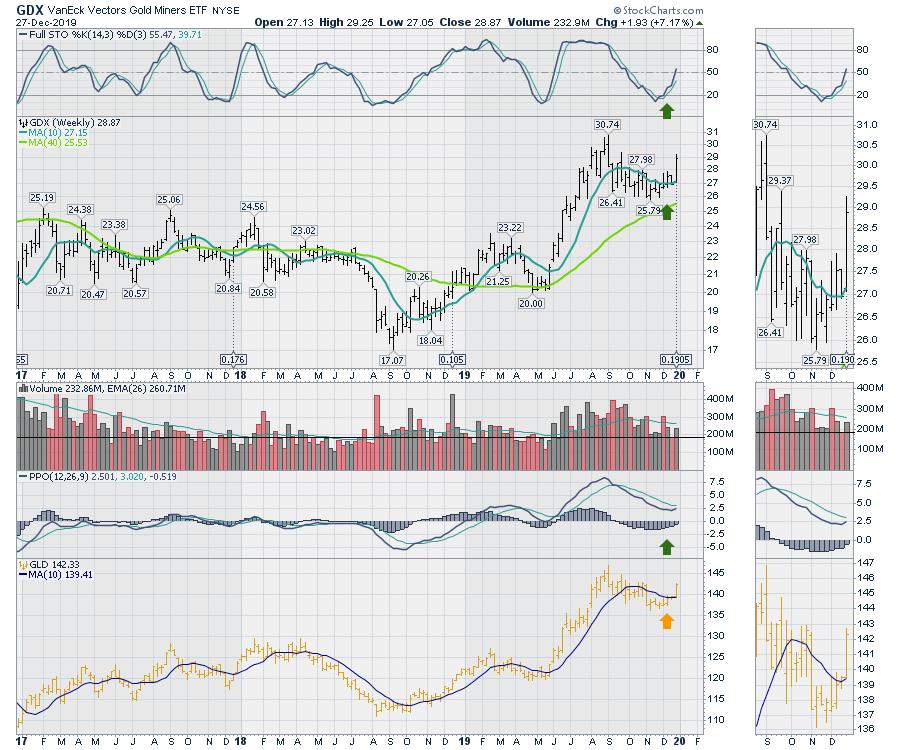
One of the common complaints about commodities and companies related to commodities is they are too volatile and need to be traded into and out of. For portfolio managers, that can be too difficult, so they end up avoiding them altogether.
For those of us willing to follow commodities, these opportunities can be nice. The GDX ETF above represents gold miners. It soared from May to August, generating a 50% move. This week appears to be another launch point for the next rally.
I have put gold in the lower panel. It was up 2%, while the miners were up 7%. The extraordinary torque in the miners is why this can be a more profitable way to play these commodity names.
Silver also followed suit this week, with the silver miners making a big move as well. The SIL ETF represents silver miners, whereas SLV represents Silver.
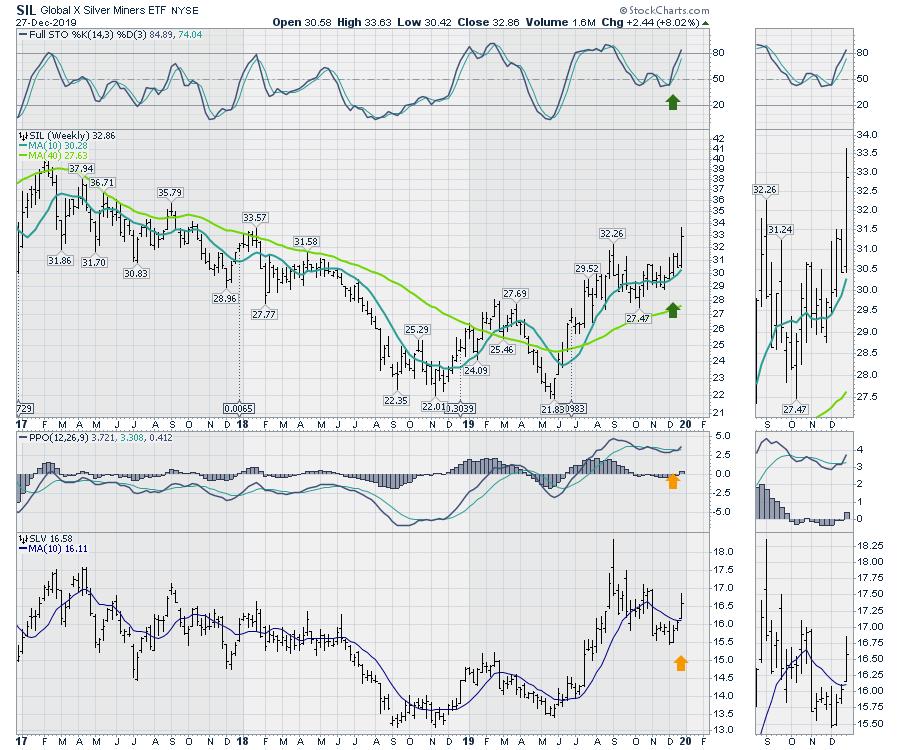
So we see that precious metals fired up this week, and the miners fired up even more. With the Silver miners ETF (SIL) breaking out to new 52-week highs, that may attract more investors as well. If you are looking for new ideas for your portfolio, the setup is nice here.
This is the last chance before the Market Vision 2020 event with all your favorite StockCharts authors! If you would like more information, follow this link! It all happens next Saturday, January 4th. With the great returns from 2019, this might be a good time to investigate some of your favorite technical analysts from StockCharts!
|
| READ ONLINE → |
|
|
|
| SPECIAL EVENT ANNOUNCEMENT |
| Don't miss your chance to hear David Keller, Chief Market Strategist at StockCharts.com! David will be a featured presenter at the upcoming Orlando MoneyShow conference, February 6th - 8th. The event is free to register and attend, and you'll have the chance to hear David speak alongside a long list of other industry legends and market experts. Click the banner below to learn more. |
 |
| LEARN MORE → |
|
| The Traders Journal |
| Two Expectations For The New Year |
| by Gatis Roze |

Happy New Year! In my world, this means looking backwards over the year just past and looking forwards to set goals for the year to come. A recent article in the Wall Street Journal about GRACE provided the catalyst for my thinking herein about my own expectations in the coming year. Yes, this is about us individual investors.
Grace is a powerful word. It can become the cornerstone of both your personal and your financial life — thereby enhancing both simultaneously. Stay with me. For myself, grace is two parts. The first part is about how you interface with those around you. The second is about how you deal with your own personal issues. Let me briefly elaborate.
- I'll label the first point as "External Conduct". Here, grace is represented by whether you deal honestly and ethically with other people. Is your moral compass consistently dialed in to represent your principles? Do you act in a decent manner as you interact with the world around you?
- The second point is what I'll call "Internal Conduct". Here, grace is about seeking illumination and humility about your own short comings when things inevitably go wrong. Being willing to pursue a deep desire to seek reality with an objective mindset is the goal. In other words, hear what the markets are actually telling you — not what you want to hear. The purpose is to aspire to achieve 100% truthfulness, allowing you to be at peace with yourself and your decisions and thereby become the best version of yourself possible.
I wish we could legislate grace but we cannot. My hope is that you embrace both external and internal grace to diminish your stress, make yourself a better investor and just perhaps make our planet a better place.
Here's to your future prosperity in the New Year!
Trade well; trade with discipline!
- Gatis Roze, MBA, CMT
StockMarketMastery.com
|
| READ ONLINE → |
|
|
|
| DecisionPoint |
| This Sector is Poised to Outperform According to DecisionPoint Indicators |
| by Erin Swenlin |
Carl and I have put together our Sector SPDR ChartList that includes all of our major indicators on each chart. I've been watching the sectors closely; most of the sectors Year-To-Date have been performing well, although none have really outpaced Technology when you look at the Sector Summary:
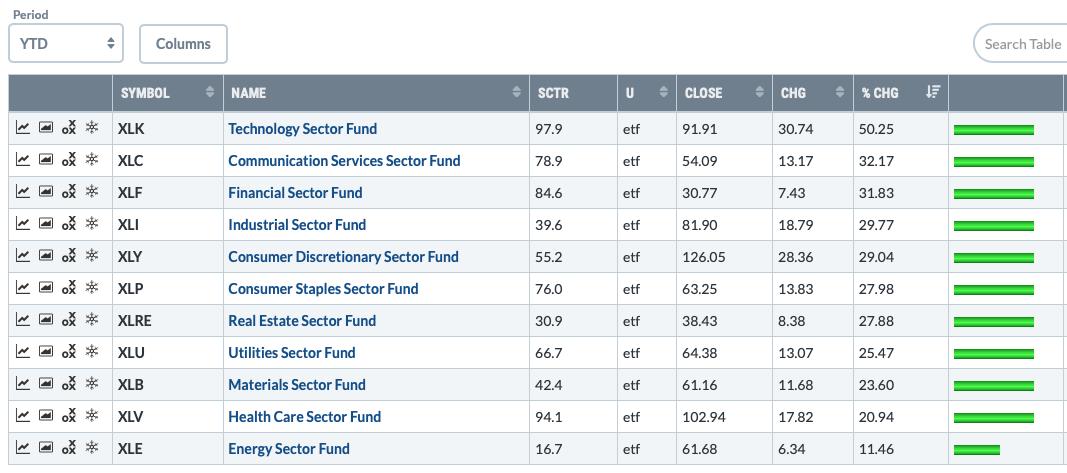
While I am still bullish on the Technology (XLK) sector, I think that Consumer Discretionary (XLY) is more bullish.
XLK is on the overbought side for the Price Momentum Oscillator (PMO). My biggest issue is that volume isn't actually supporting the breakout all-time highs. Notice that the first two OBV tops show rising tops. Compare last month's price top to the previous two and you can see it is much higher. Unfortunately, the OBV didn't show the same breakout. Additionally, notice the very overbought weekly PMO in the second chart below. Remember, I'm not bearish on XLK; I just think that Consumer Discretionary (XLY) looks much better.
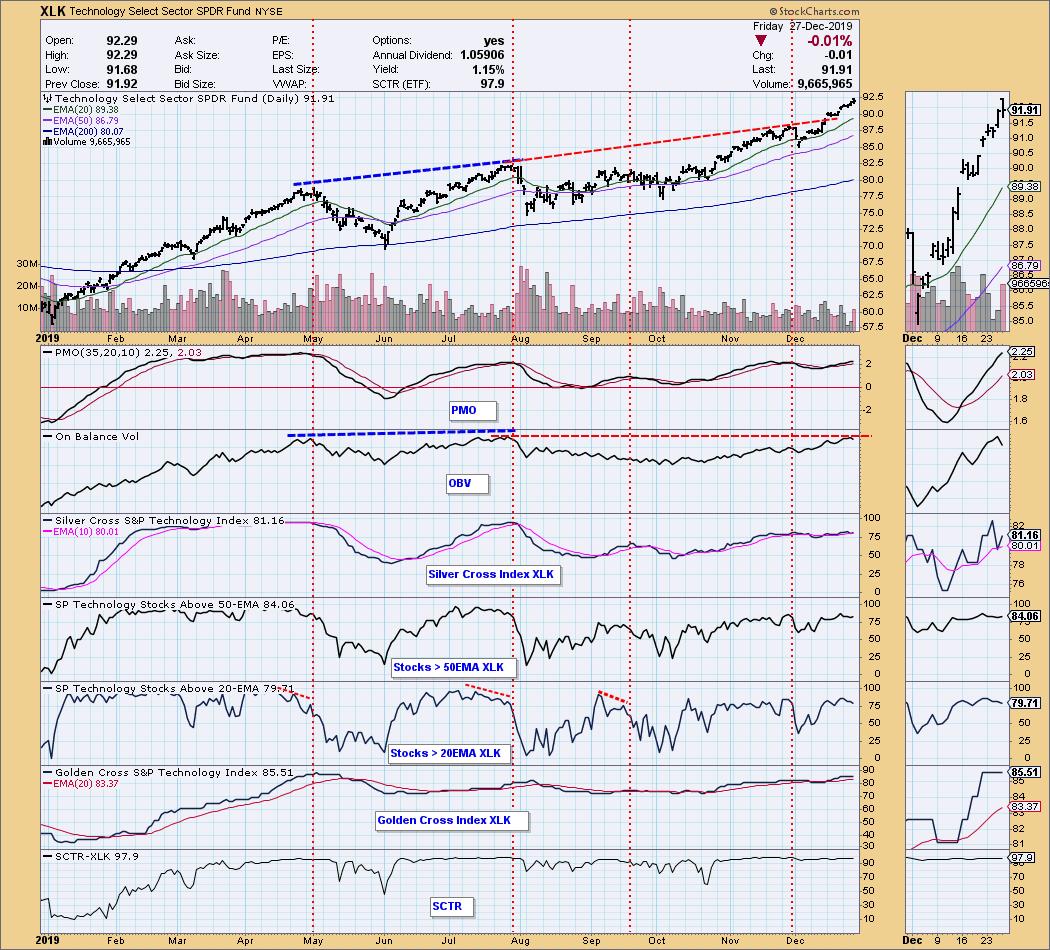

Now, let's look at Consumer Discretionary. Unlike XLK, the PMO is not overbought. Volume is supporting the breakout. Notice that the current price top is above the previous price tops and, with that last price breakout, we see the OBV breaking out. The SCTR is "mid-range" and is trending higher. I think the weekly chart is very bullish as well. The weekly PMO is about to generate a BUY signal and is not overbought.
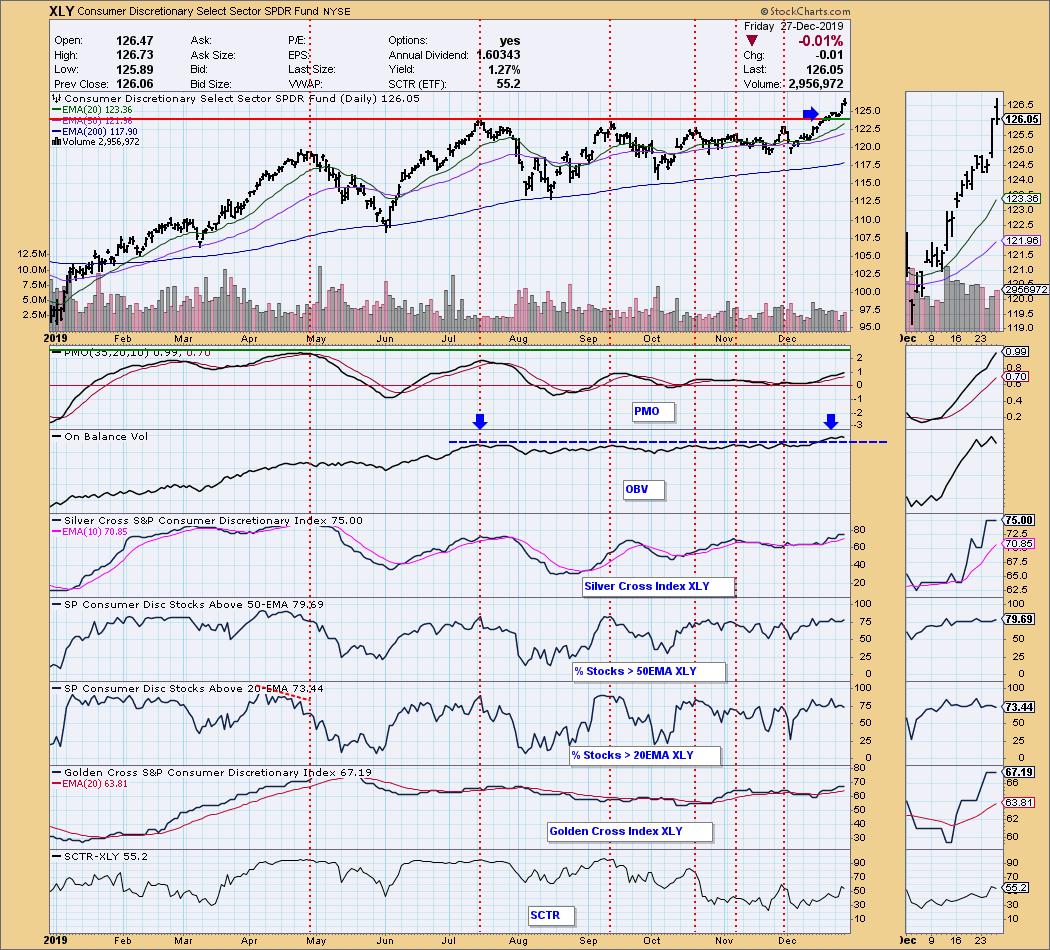
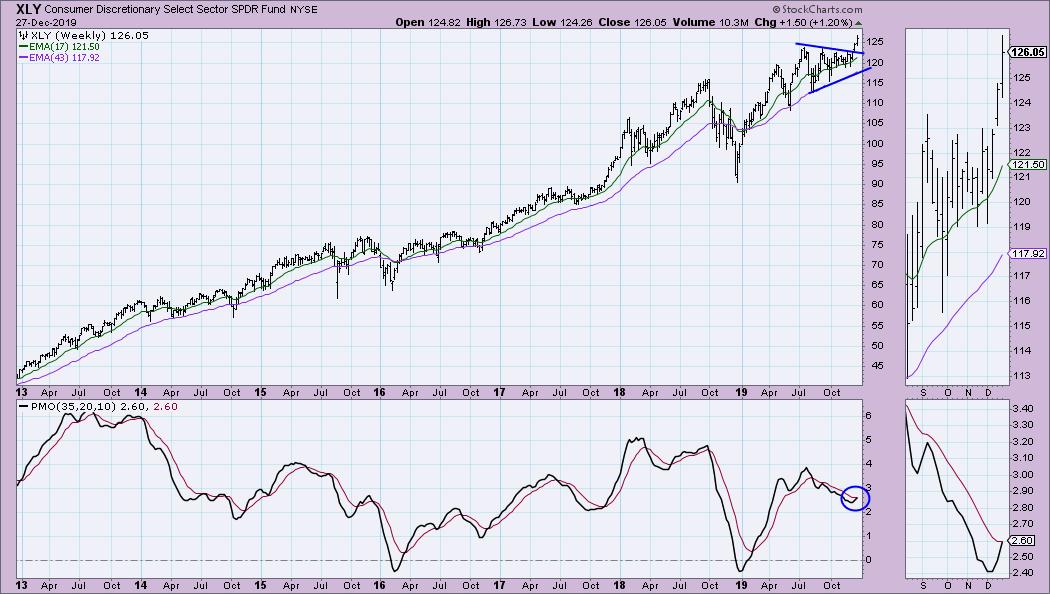
Conclusion: I'm bullish going into the New Year on the market in general. My sector pick for the next quarter would have to be XLY.
Watch new episodes of DecisionPoint with Carl & Erin Swenlin LIVE on Mondays 5pm ET or on the StockCharts TV YouTube channel here! (There will not be an episode this coming Monday as the show is on hiatus for the holidays.)
Technical Analysis is a windsock, not a crystal ball.
Happy Charting! - Erin
erinh@stockcharts.com
Helpful DecisionPoint Links:
Erin's PMO Scan
DecisionPoint Shared ChartList and
Trend Models
Price Momentum Oscillator (PMO)
On Balance Volume
Swenlin Trading Oscillators (STO-B and STO-V)
ITBM and ITVM
SCTR Ranking
**Don't miss DecisionPoint Commentary! Add your email below to be notified of new updates"**
|
| READ ONLINE → |
|
|
|
|
|
| ChartWatchers |
| What's in a Forecast? See for Yourself and Be Amazed! |
| by John Hopkins |
On September 23, our Chief Market Strategist Tom Bowley, who had just returned to EarningsBeats.com after 4.5 years as Senior Technical Analyst at StockCharts, made a bold call. Right as the market was in danger of rolling over, Tom saw something that caught his attention, which he shared with EarningsBeats members in his Daily Market Report. It was a prescient call, as you can see in the chart below.
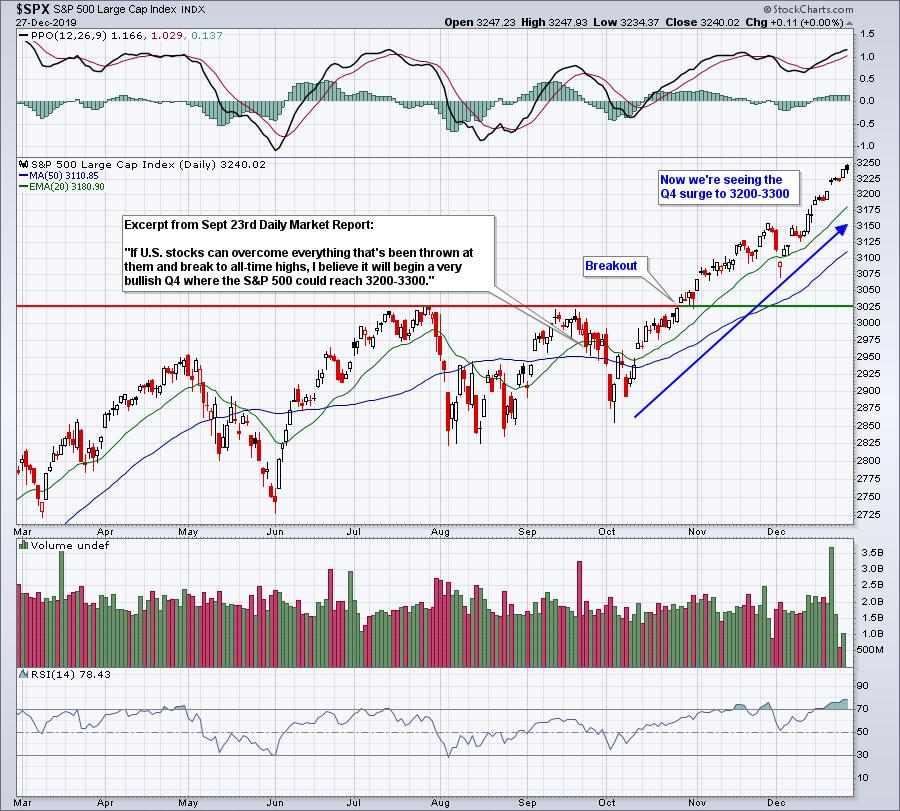
These types of forecasts, where the S&P climbs over 7% to new record highs, don't always work out. But when you have someone who makes predictions that often turn out to be true, it's worth paying attention.
For example, I went back and looked at a number of stocks Tom shared with members during September and October that had stunning results. One example is IMMU, a stock that was highlighted in Tom's September 30 Daily Market Report. You can see the results below.
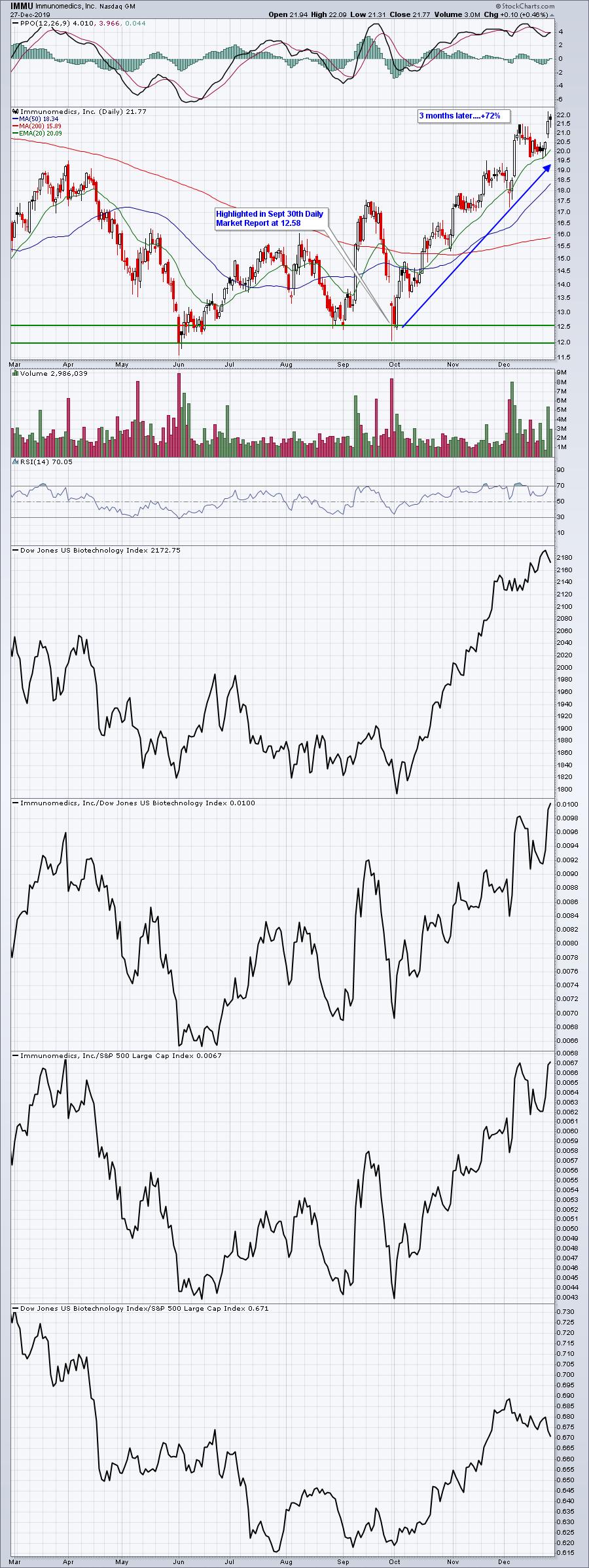
Does every trade suggestion we make to our members work out as well as IMMU? Of course not! In fact, we've provided stocks that have lost ground since they were highlighted, but we advocate keeping stops in play. Managing small losses is fine when you have big winners, like those shown above. But if you want to be impressed even more, click here to see some of the other stocks Tom brought to the attention of EarningsBeats members over the past few months.
I'm pointing out the potential power of accurate forecasts because EarningsBeats is about to conduct its first major online conference - Market Vision 2020, which will feature some of the finest minds in technical analysis, including our Keynote Speaker John Murphy. This one-day event will take place on Saturday, January 4 and is a MUST-attend for those investors and traders who want to put themselves in a position to succeed during 2020. You can click here to learn more and save a seat. You DON'T want to miss this one!
At your service,
John Hopkins
EarningsBeats.com
Better Timing. Better Trades.
|
| READ ONLINE → |
|
|
|
| MORE ARTICLES → |
|


 2019 was a year with lots of distractions, and yet the S&P 500 recorded 52-week highs in six of the last nine months. The index surged 17.7% the first four months and recorded its first 52-week high in late April. It then finished strong with a new high in late December and is currently around 10% above its April high. Distractions were prevalent throughout these new highs as we heard about the tariff battle, the inverted yield curve and relative weakness in small-caps, among other things.
2019 was a year with lots of distractions, and yet the S&P 500 recorded 52-week highs in six of the last nine months. The index surged 17.7% the first four months and recorded its first 52-week high in late April. It then finished strong with a new high in late December and is currently around 10% above its April high. Distractions were prevalent throughout these new highs as we heard about the tariff battle, the inverted yield curve and relative weakness in small-caps, among other things.















